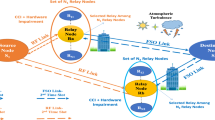Abstract
In this paper, we have proposed a new combining technique named as multiple gain combiner (MGC) for single-relay cooperative FSO communication systems. The first objective of this paper is to test the experimental feasibility of single-relay cooperative FSO communication system. The next objective is to ascertain the performance of a cooperative FSO link in the presence of simulated fading effect generated by means of modified optical chopper. The last objective is to determine the performance improvement of our proposed MGC combining method over conventional equal gain combining method. Bit error rate performance of the relay system is tested for single-relay cooperative FSO link under weak and strong fading conditions simulated with the modified optical chopper, which shows that the significant performance improvement can be obtained with the use of cooperative diversity. Rsoft-Optsim with MATLAB® co-simulation results show the same trend of performance for the same level of fading present in the system, thereby validating the fading mechanism as obtained by means of modified optical chopper.












Similar content being viewed by others
References
www.fsona.com Accessed April 2016
Ghassemlooy, Z., Popoola, W., Rajbhandari, S.: Optical Wireless Communication. CRC Press, Boca Raton (2012)
Tsiftsis, T.A., Sandalidis, H.G., Karagiannidis, G.K., Uysal, M.: Optical wireless links with spatial diversity over strong atmospheric turbulence channels. IEEE Trans. on Wirel. Commun. 8(2), 951–957 (2009)
Safari, M., Uysal, M.: Relay-assisted free-space optical communication. IEEE Trans. Wirel. Commun. 7(12), 5441–5449 (2008)
Simon, M.K., Alouini, M.S.: Digital Communication over Fading Channels: A Unified Approach to Performance Analysis. Wiley, Hoboken (2000)
Abou-Rjeily, C., Haddad, S.: Cooperative FSO systems: performance analysis and optimal power allocation. J. Lightw. Technol. 29(7), 1058–1065 (2011)
Fan, J., Zhou, X., Liu, J.: Design and evaluation of an IDMA cooperative relay free-space optical system. In: International Conference on Space Optical Systems and Applications, Santa Monica, CA, pp. 358–362 (2011)
Karimi, M., Nasiri-Kenari, M.: Outage analysis of relay-assisted free-space optical communications. IET Commun. 4(12), 1423–1432 (2010)
Dubey, V., Chandra, V., Chadha, D.: Bit error rate and reliability analysis of cooperative communication in free-space optical systems. Photon Netw. Commun. 28, 92–101 (2014)
Ijaz, M., Ghassemlooy, Z., Ansari, S., Adebanjo, O., Minh, H. Le and Rajbhandari, S.: Experimental investigation of the performance of different modulation techniques under controlled FSO turbulence channel. In: 5th International Symposium on Telecommunications (IST), Tehran, pp. 59–64, (2010)
Rajbhandari, S., Ghassemlooy, Z., Antony, P.: Experimental error performance of modulation schemes under a controlled laboratory turbulence FSO channel. J. Lightw. Technol. 33(1), 244–250 (2015)
Anguita, J. A., Cisternas, J. E.: Experimental evaluation of transmitter and receiver diversity in a terrestrial FSO link. In: IEEE Globecom 2010 Workshop on Optical Wireless Communications, Miami, FL, pp. 1005–1009, (6–10) (2010)
Kazaura, K., Omae, K., Suzuki, T., Matsumoto, M.: Enhancing performance of next generation FSO communication systems using soft computing based predictions. Opt. Express 14(12), 4958–4968 (2006)
Ijaz, M., Ghassemlooy, Z., Minh, H. Le, Rajbhandari, S., Perez, J., Gholami, A.: Bit error rate measurement of free space optical communication links under laboratory-controlled fog conditions. In: 16th European Conference on Networks and Optical Communications (NOC)- 2011, Newcastle-Upon-Tyne, pp. 52–55 (2011)
Dhawan, K., Chadha, D., Chandra, V.: An experimental study for enhanced availability of free-space optics systems over hybrid free-space optics/radio frequency systems using switching scheme based on on–off keying and multiple pulse position modulation schemes with variable data rates. Fiber Integr. Opt. 30(6), 356–374 (2011)
Libich, J., Komanec, M., Zvanovec, S., Pesek, P., Popoola, W.O., Ghassemlooy, Z.: Experimental verification of an all-optical dual-hop 10 Gbit/s free-space optics link under turbulence regimes. Opt. Lett. 40(3), 391–394 (2015)
Popoola, W.O., Ghassemlooy, Z., Allen, J.I.H., Leitgeb, E., Gao, S.: Free-space optical communication employing subcarrier modulation and spatial diversity in atmospheric turbulence channel. IET Optoelectron. 2(1), 16–23 (2008)
http://www.bentham.co.uk/218m.htm Accessed April 2016
Andrews, L.C., Phillips, R.L., Hopen, C.Y.: Laser Beam Scintillation with Applications. SPIE Press, Bellingham (2001)
Author information
Authors and Affiliations
Corresponding author
Rights and permissions
About this article
Cite this article
Dubey, V., Chadha, D. & Chandra, V. Experimental validation of multiple gain combiner in single-relay cooperative FSO communication systems. Photon Netw Commun 37, 110–119 (2019). https://doi.org/10.1007/s11107-018-0800-x
Received:
Accepted:
Published:
Issue Date:
DOI: https://doi.org/10.1007/s11107-018-0800-x




